

Zitierweise / cite as:
Carakasaṃhitā: Ausgewählte Texte aus der Carakasaṃhitā / übersetzt und erläutert von Alois Payer <1944 - >. -- Anhang B: Tierbeschreibungen. -- Varanus sp. -- Fassung vom 2010-12-09. -- URL: http://www.payer.de/ayurveda/tiere/varanus.htm
Erstmals publiziert:
Überarbeitungen:
Anlass: Lehrveranstaltung SS 2007
©opyright: Dieser Text steht der Allgemeinheit zur Verfügung. Eine Verwertung in Publikationen, die über übliche Zitate hinausgeht, bedarf der ausdrücklichen Genehmigung des Verfassers
Dieser Text ist Teil der Abteilung Sanskrit von Tüpfli's Global Village Library
WARNUNG: dies ist der Versuch einer
Übersetzung und Interpretation eines altindischen Textes. Es ist keine
medizinische Anleitung. Vor dem Gebrauch aller hier genannten Heilmittel wird
darum ausdrücklich gewarnt. Nur ein erfahrener, gut ausgebildeter ayurvedischer
Arzt kann Verschreibungen und Behandlungen machen!
Falls Sie die diakritischen Zeichen nicht dargestellt bekommen, installieren Sie eine Schrift mit Diakritika wie z.B. Tahoma.
Verwendete und zitierte Werke siehe: http://www.payer.de/ayurveda/caraka000b.htm
In Indien kommen drei Spezies von Waranen vor:

Abb.:
Varanus bengalensis - Bengalenwaran,
Machtkampf zweier Männchen, Bandipur National Park, Karnataka (ಕನಾ೯ಟಕ)
[Bildquelle:
Jayanth Sharma. --
http://www.flickr.com/photos/jayanthsharma/381827521/. -- Zugriff am
2007-07-17. --
![]()
![]()
![]() Creative
Commons Lizenz (Namensnennung, keine kommerzielle Nutzung, keine
Bearbeitung)]
Creative
Commons Lizenz (Namensnennung, keine kommerzielle Nutzung, keine
Bearbeitung)]
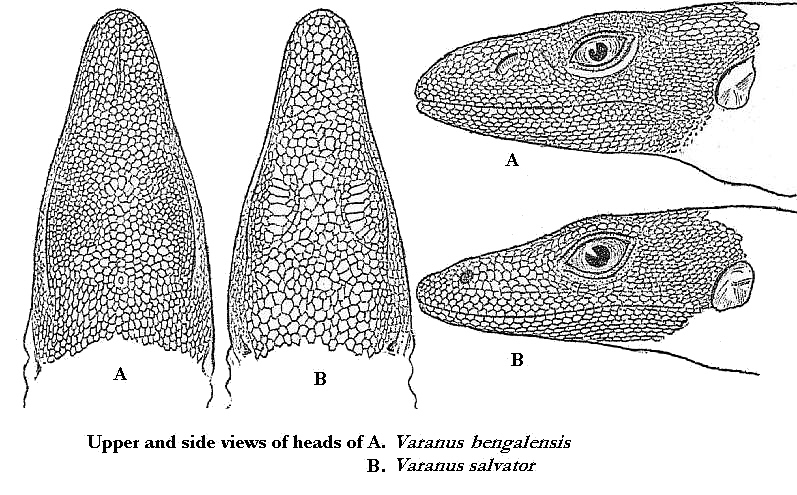
Abb.: Unterschiede zwischen Varanus bengalensis und
Varanus salvator
[Bildquelle. Wikipedia]
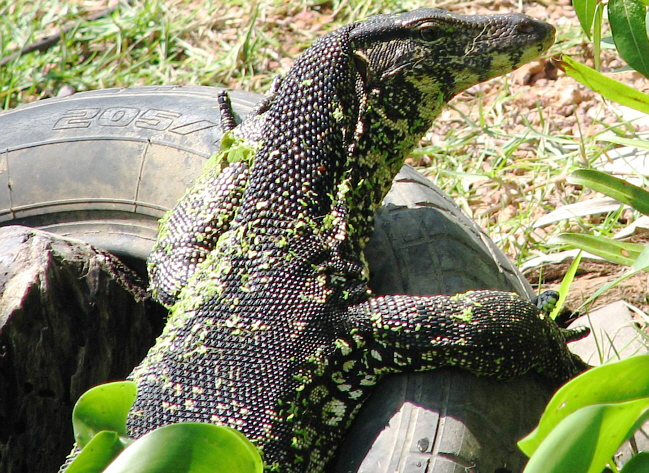
Abb.:
Varanus salvator - Bindenwaran, Sri Lanka
[Bildquelle: Preveen
/ Wikipedia. -- GNU FDLicense]
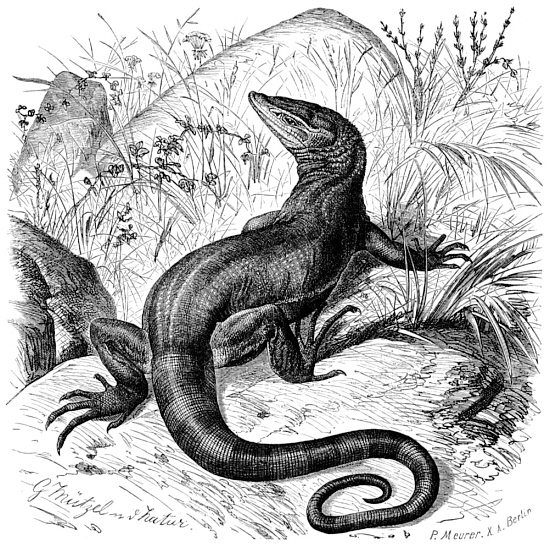
Abb.:
Varanus griseus - Wüstenwaran
[Bildquelel: Brehm's Tierleben, Bd. 7, 1892]
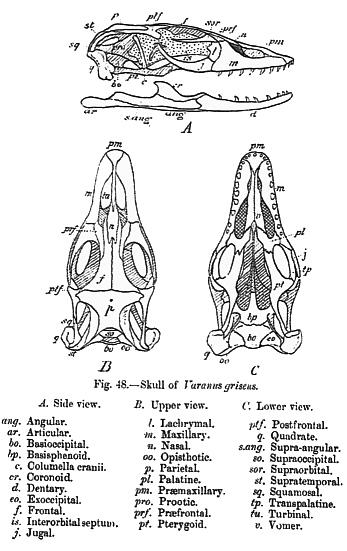
Abb.: Schädelbau von
Varanus griseus - Wüstenwaran
[Bildquelle: Wikipedia]
Kipling:
"The large lizard, varanus dracaena, which is perfectly innocuous, like all Indian lizards, is called the bis-cobra by some, though the name really belongs, according to others, to a different creature, and is counted highly dangerous, while it is believed to be so strong that Sivaji, the renowned Marathi chief, escaped from a fortress wherein he was confined by being dragged up the wall by one of these creatures, and some say they are habitually used by burglars for this purpose. I used to keep one of these harmless animals, and even while holding it in one hand I have been assured by natives of its vast strength and deadliness."
[Quelle: : Kipling, John Lockwood <1837-1911>: Beast and man in India : a popular sketch of Indian animals in their relations with the people. -- London ; New York : Macmillan, 1904. -- xii, 401 S. : Ill. ; 24 cm. -- S. 317. -- Online: http://www.archive.org/details/beastmaninindiap00kipliala. -- Zugriff am 2007-10-25]
Cunningham:
"Every
large suburban garden containing a pond and dense masses of shrubbery is almost sure to be occasionally visited by specimens of the great water-lizard, Varanus salvator. Owing to their large size and aquatic habits, they are often mistaken for young crocodiles, and, as they have most voracious appetites and jaws to match them, they are by no means welcome guests where fowls are kept, or fish are preserved in ponds. Their normal diet consists of frogs, toads, and fish, but they are always ready to avail themselves of any opportunity of varying it with birds, and have an evil repute for a liking for young chickens. Whilst on land they are repulsive and debased-looking creatures, with dirt-coloured coats, and an awkwardly waddling gait, which can, however, in emergencies carry them over the ground with astonishing rapidity. To appear to advantage they must be in the water where they are quite at ease, swimming at a great pace with their heads held well out of the water and their great tails lashing from side to side, or diving and remaining below the surface to come up at a great distance from the points at which they disappeared. In ordinary circumstances they come to the surface of the water after brief intervals, but when alarmed they can remain submerged for a long time with complete impunity. Their power in this respect is not, however, equal to that of crocodiles, and continuous submersion during periods of from three to four hours' duration is enough to drown them. As a rule, they do not venture very far from water, and, on any alarm they always make for it as quickly as possible. Their tails not only serve as very efficient propellers and steering-gear, but are also formidable weapons, owing to their great reach and the violence with which they can be lashed about. At one time, and much against the wishes of my servants, I kept a very large Varanus in a cage in the verandah of the first floor of my house. He was the object of much horror to the household, as the uneducated natives firmly believe that the long, forked, flickering black tongue, that so often comes out from between the formidable jaws, is endowed with such potently venomous properties, that its slightest touch is fatal. The cage was a very strong one, and was large enough to contain an earthenware bath, in which the prisoner spent most of his time. Every now and then, however, he managed to break loose and escape over the top of a long terrace-roof that was reached by a short flight of steps descending from the verandah. The process of recapture was attended by the wildest excitement and apprehension. The fugitive was pursued by a mob of men, armed with thick sticks and horse-blankets from the stables, and all in a state of the greatest dread of the deadly tongue and formidable tail. Matters reached a climax when he was cornered and eventually secured under the blankets, hissing aloud, snapping his jaws, and "swindging the scaly Horrour of his folded tail." His appetite was truly astonishing, and he seemed to be always ready to do away with fifteen large toads at a single meal. Dogs are usually eager to hunt them, but exercise a wise caution in coming to close quarters with them. They usually keep to the ground, but, when in quest of eggs or birds, they sometimes climb to a considerable height among tangled masses of shrubs and creepers."[Quelle: Cunningham, D. D. (David Douglas) <1843-1914>: Some Indian friends and acquaintances; a study of the ways of birds and other animals frequenting Indian streets and gardens. -- London : J. Murray, 1903. -- viii, 423 S. : Ill. ; 21 cm. -- S. 324 - 326. -- Online: http://www.archive.org/details/someindianfriend00cunnrich. -- Zugriff am 2007-09-15]
Lydekker:
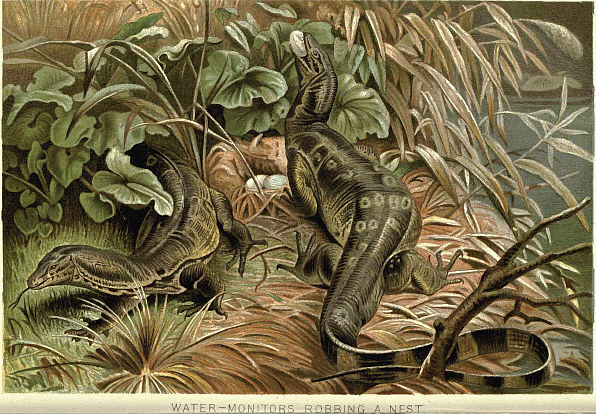
"THE MONITORS.
Family VARANIDJE.
No
better instance of the essential difference in the distribution of lizards as compared with tortoises is afforded than by those lizards commonly known as monitors. The tortoises of Australia, as we have already seen, belong to a different suborder from those of India, while there are no genera common to Australia and Africa. The monitors, all of which are included in the single genus Varanus, are, however, common to the three countries named, while one species actually ranges from India to Australia. That this widespread generic distribution is not a feature of the present epoch is proved by the occurrence of fossil monitors in both the two latter countries; whereas we have no evidence that they possessed genera of tortoises in common. Before proceeding further, it is well to mention that the Egyptian representative of the group is known to the natives by the name of ouaran, which appears to be the Arabic term for lizards in general. Transliterated as waran, this word has been confused with the German warnen, to warn, whence these reptiles have been termed warn-eidechsen, or warning lizards; this, again, having been translated into monitors a name which, however erroneous in origin, is too well established to be superseded.The monitors are distinguished from all the lizards hitherto described by the long and deeply-forked tongue, which is capable of being protruded far in front of the lips, and is furnished at the base with a sheath, into which it can be withdrawn, as in snakes. Including the largest
members of the suborder, monitors are further characterised by the long body, the broad, uncrested back, the well-developed, five-toed limbs, and the long tail, which is very frequently markedly compressed. The head is covered with small polygonal scales ; the eyelids are well developed ; the opening of the ear is distinct ; and the head is covered with small scales. In the skull we may notice alike the absence of a bony roof over the temporal fossae, and of teeth on the palate ; while it is further remarkable for the union of the two nasal bones into a single ossification. The teeth are large and pointed, with expanded bases fixed to the sides of the jaws. On the back the scales are rounded and bordered by rings of minute granules, so that they do not overlap ; while in the under surface we find the squared scales arranged in cross rows. Pores are absent both on the under surface of the thigh and in front of the vent. A peculiarity of the group is the presence of an imperfect midriff, found elsewhere among reptiles alone in the crocodiles.Monitors inhabit Africa, Southern Asia, Oceania, Papua, and Australia, and are represented by nearly thirty living species, the largest of which attains a length a little short of 7 feet. A fossil species from Northern India was, however, probably 12 feet long, while one from Australia could not have fallen much, if at all, short of 30 feet. The group is an isolated one, without near relationship to any other family.
The genus may be divided into four distinct sections, the first of which is represented solely by the desert-monitor (Varanus griseus) of North-Western Africa and South-Western Asia, extending from Arabia and the Caspian to North-Western India. This species differs from all the rest in that the nostrils are in the form of oblique slits, while the tail, except sometimes near its tip, is cylindrical. Attaining a length of 4 feet 2 inches, and inhabiting the deserts of North-Western India, and thence westwards through Southern Asia to the Caspian and North Africa, it takes its name from its greyish yellow colour, which may be relieved by brown crossbars on the back and tail, and streaks of the same hue along the sides of the neck ; the young always having yellow spots and dark bars. In accordance with its sombre coloration, this species is an inhabitant of sandy deserts.
A far handsomer lizard than the last is the Cape monitor (Varanus albigularis) of Southern and South-Eastern Africa, where it is commonly known to the Boers as the " adder." It is the first representative of the second group of the genus, in which, while the nostrils are in the form of oblique slits, the tail is compressed and keeled. Belonging to a subgroup characterised by the smooth scales of the abdomen, it is further distinguished by the absence of large (supraocular) scales above the eyes, by the nostril being three times as far from the snout as from the eye, and by the small size of the scales. It is slightly inferior in size to the last, and has the upper-parts greyish brown, banded and spotted with yellow, and the under-parts yellowish. It generally frequents cliffs, or low rocky hills, in the interstices of which it delights to hide, coming out to bask on the flat surfaces.
Gray's monitor (Varanus grayi) is an example of a second subgroup in which the abdominal scales are keeled.
In the third great group, of which we take as our first example the water-monitor (Varanus salvator), represented in the coloured Plate, round or oval nostrils are accompanied by a compressed tail. In the species in question there is a series of transversely elongated scales above the eyes, the oval nostril is situated as far from the eye as from the tip of the snout, there are more than eighty transverse rows of scales between the fold on the throat and the groin, and the scales on the nape are not larger than those of the back. This fine species, which ranges from India through the Malayan region and China to Australia, attains a length of nearly 7 feet, and is the largest of the genus. In colour it is dark brown or blackish above, with yellow rings ; the snout being generally lighter, with transverse black bars, and a dark band, bordered by a yellow one, running backwards from the eye ; the under surface being uniformly yellow. The water-monitor frequents marshy localities, being often found on trees overhanging rivers, and taking readily to the water, either fresh or salt.
The last species that we notice is the well-known Nile monitor ( Varanus niloticus), whose range extends all over Africa except a portion of the north-western regions. Belonging to the same great group as the last, it represents a second subgroup distinguished by the equality in the size of the scales above the eyes : while it is distinguished from its allies by the nostril being rather nearer the tip of the eye than the snout. In size it is somewhat larger than the desert monitor. The colour of the adult is brownish or greenish grey, with darker reticulate markings, and more or less distinct yellowish eye-like spots on the back and limbs; while beneath it is yellowish, crossed by some dark bands. This species is likewise found in the neighbourhood of water, generally building itself a nest among the bushes on the banks, especially of those streams that dry up in the hot season.
The Papuan monitor (Varanus prasinus) of New Guinea and the islands of Torres Straits, may be cited as an example of the fourth group of the genus, in which, while the nostrils are round, the tail is nearly or quite cylindrical.
As will be gathered from the foregoing, the monitors present considerable diversity of habitat, although the majority prefer the neighbourhood of water. The Papuan species is, however, believed to be arboreal. All are carnivorous in their diet, feeding on frogs, snakes, the smaller mammals and birds, as well as the eggs of both birds and reptiles, especially crocodiles. Their movements are extremely rapid, both on land and in water; and many a sportsman in his first day's snipe-shooting in the rice-fields around Calcutta has been startled by the sudden rush of the common Indian species (Varanus bengalensis) as it darts among the herbage close to his feet. Those species in which the tail is the most compressed are the best swimmers; this appendage serving as a powerful propeller in the water, and being also used as a weapon of offence on land. In order to enable them to remain under water for some time, the nostrils are expanded into large cavities within the snout ; and when the apertures are closed these pouches serve as reservoirs of air. Writing of the great watermonitor, Cantor says that it is "very numerous in hilly and marshy localities of the Malayan Peninsula. It is commonly during the day observed in the branches of trees overhanging rivers, preying upon birds and their eggs and smaller lizards, and when disturbed it throws itself from a considerable height into the water. It will courageously defend itself with teeth and claws and by strokes of the tail. The lowest castes of Hindus capture these lizards commonly by digging them out of their burrows on the banks of rivers, for the sake of their flesh." Professor V. Ball gives the following account of a meeting with a lizard of the same species in the Nicobars : "As I did not care to shoot him, though I wanted to capture him, I threw stones at him, whereupon he hissed and lashed his tail in a manner that might prove alarming to anyone not knowing the harmless nature of the beast. As I was pressing him into a corner, he made a rush into the waves, but returned, apparently not liking the surf. Just as I thought he could not escape, he made a sudden dart into the water, dived through the surf, and disappeared."
From observations made on specimens in captivity, it appears that these lizards eat eggs by taking them in their mouths, raising their heads, and then breaking the shells, so that the contents are allowed to run down their throats. Although but little is ascertained regarding their breeding-habits, monitors are known to lay white, soft-shelled eggs, which are deposited sometimes in the nests of white ants. As many as twenty-four eggs, of a couple of inches in length, have been taken from the body of a single female. By the Burmese these eggs are much relished as articles of food, and command a higher price in the market than hens' eggs."
[Quelle: Lydekker, Richard <1849-1915>: The royal natural history / edited by Richard Lydekker ; with preface by P.L. Sclate. -- London ; New York : F. Warne, 1893-96. -- 6 Bde. : ill. (some col.) ; 26 cm. -- Bd. 5. -- S. 149ff. -- Online: http://www.archive.org/details/royalnaturalhist05lyderich. -- Zugriff am 2007-09-27]